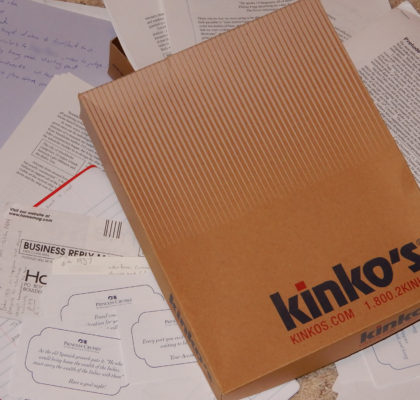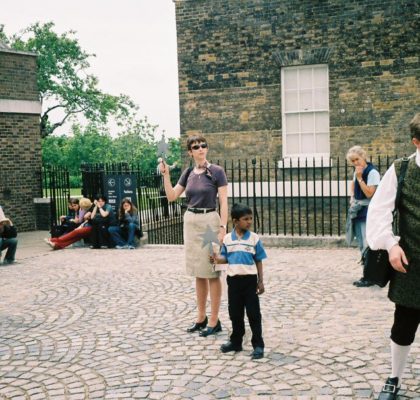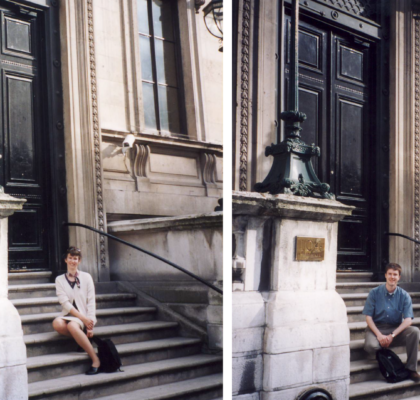- March 4, 2001 (Day -4)
- March 6, 2001 (Day -2)
- March 7, 2001 (Day -1)
- March 8, 2001 (Day 1)
- March 10, 2001 (Day 3)
- March 11, 2001 (Day 4)
- March 12, 2001 (Day 5)
- March 13, 2001 (Day 6)
- March 14, 2001 (Day 7)
- March 15, 2001 (Day 8)
- March 16, 2001 (Day 9)
- March 17, 2001 (Day 10)
- March 18, 2001 (Day 11)
- March 19, 2001 (Day 12)
- Time Check: Day 12
- March 20, 2001 (Day 13)
- March 21, 2001 (Day 14)
- March 22, 2001 (Day 15)
- March 23, 2001 (Day 16)
- March 24, 2001 (Day 17)
- March 25, 2001 (Day 18)
- March 26, 2001 (Day 19)
- March 27, 2001 (Day 20)
- March 28, 2001 (Day 21)
- March 29, 2001 (Day 22)
- March 30, 2001 (Day 23)
- Time Check: Day 23
- March 31, 2001 (Day 24)
- April 1, 2001 (Day 25)
- April 2, 2001 (Day 26)
- April 3, 2001 (Day 27)
- April 4, 2001 (Day 28)
- April 5, 2001 (Day 29)
- Time Check: Day 29
- April 6, 2001 (Day 30)
- April 7, 2001 (Day 31)
- April 8, 2001 (Day 32)
- April 9, 2001 (Day 33)
- April 10, 2001 (Day 34)
- April 11, 2001 (Day 35)
- Time Check: Day 35
- April 12, 2001 (Day 36)
- April 13, 2001 (Day 37)
- April 14, 2001 (Day 38)
- April 15, 2001 (Day 39)
- April 16, 2001 (Day 40)
- Time Check: Day 40
- April 17, 2001 (Day 41)
- April 18, 2001 (Day 42)
- April 19, 2001 (Day 43)
- Time Check: Day 43
- April 20, 2001 (Day 44)
- Intermission
- April 21, 2001 (Day 45)
- April 22, 2001 (Day 46)
- April 23, 2001 (Day 47)
- April 24, 2001 (Day 48)
- April 25, 2001 (Day 49)
- April 26, 2001 (Day 50)
- April 27, 2001 (Day 51)
- April 28, 2001 (Day 52)
- Time Check: Day 52
- April 29, 2001 (Day 53)
- April 30, 2001 (Day 54)
- May 1, 2001 (Day 55) – Part I
- May 1, 2001 (Day 55) – Part II
- May 2, 2001 (Day 56)
- May 3, 2001 (Day 57)
- May 4, 2001 (Day 58)
- May 5, 2001 (Day 59)
- May 6, 2001 (Day 60)
- May 7, 2001 (Day 61)
- Time Check: Day 61
- May 8, 2001 (Day 62)
- May 9, 2001 (Day 63)
- May 10, 2001 (Day 64)
- May 11, 2001 (Day 65)
- May 12, 2001 (Day 66)
- May 13, 2001 (Day 67)
- May 14, 2001 (Day 68)
- May 15, 2001 (Day 69)
- Time Check: Day 69
- May 16, 2001 (Day 70)
- Time Check: Day 70
- May 17, 2001 (Day 71)
- May 18, 2001 (Day 72)
- May 19, 2001 (Day 73)
- May 20, 2001 (Day 74)
- May 21, 2001 (Day 75)
- May 22, 2001 (Day 76)
- May 23, 2001 (Day 77)
- May 24, 2001 (Day 78)
- May 25, 2001 (Day 79)
- Intermission – Part II
- May 27, 2001 (Epilogue)
April 23, 2001 (Day 47): Regal Princess, Pusan, South Korea – 6pm
Doing laundry, relaxing from our afternoon outing. There is actually a bit of appeal to doing it instead of sending it out. I am sure the novelty will fade.
Health: fair. Improving, I hope. My head is still draining, but I am coughing and blowing my nose less regularly.
Morale: good. Slept in. Ate. Went on a bit of a tour. The ride – if that is what you can call passage on a ship – is smooth. The motion of the ship does not cause any problems for me. Considering the number of passengers with medicated patches behind the ears, I should count my blessings.
Anna is recovering. She slept in even later this morning, but still managed to get up and out while breakfast was still being served.
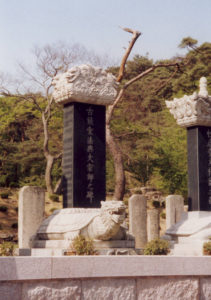
The day was sunny and warm. The good weather was a nice benefit since our stay in Pusan was only a half-day. Our experience on the Korean peninsula consisted of getting on and off buses. Since we arrived in port early, we got some bonus tour time. We chose a “Temple and Countryside” tour since it featured a trip to the UN Cemetery and a Buddhist temple. However we ended up on the only tour that did not go to the UNESCO World Heritage site, so we were deprived of being able to check another site off of the list. The “Countryside” portion of the trip must have been the one-hour drive between the UN Cemetery and the temple; “all the countryside you can see from the highway,” I am sure the fine print read.
Our guide was awesome, a wellspring of information. She made use of the extra time on the tour and all the time on the motorway by talking continuously. When questions from the Peanut Gallery dried up, she filled in the time with details about Pusan, Korea, and her opinions. It was spun gold. She started off her presentation with cultural topics tailored to a Western audience. Koreans, she said, are always in a hurry. They may push past you, step on your feet but it is not malicious, so do not get upset – the implication being that Koreans do it to each other as well. Korean tradition also counts age in 60-year cycles. When you turn 60 you have a big party and get a new birthday. From then on, you start counting your age over again. At 62 Western years, you are 2 Korean years old. Surprised US marketing agencies have not caught on to this yet.
Our guide also explained the physical differences that make Koreans different from other Asians: they have a single lid on their eyes, lighter skin, a narrow nose, shorter legs, and even-shorter tempers. She can tell difference between Asian groups but all of us Westerners look the same.
Korea is smaller than the area of Lake Michigan. Mountains cover about 70 percent of the country. Industries involved in manufacturing, such as shipbuilding and semiconductors, are a large sector of the economy. Key imports seem to be US highway markers: the shield marking Highway 1 had the same red, white, and blue design as the US.
Korean history was divided into blocks: Choson period, Chinese period, Japanese period, Korean War, post-war, and post-1972. Most Koreans are Confucians, more of a way of life than a religion. Buddhism and Christianity are also popular. Christianity caused a great uproar when the missionaries first arrived. The tenets that all people were equal in the eyes of God conflicted with the social stratification espoused by Confucianism.
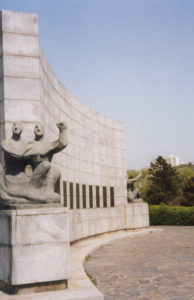 The Korean War cemetery was respectful and sedate. It was arranged in three tiers. At the very bottom a relatively newly added monument was dedicated to all who lost their lives. On the other two sides of the triangle shape were plaques for each country that played a part in the UN forces, what they contributed and how many died. The land used for the cemetery is owned and controlled by the United Nations.
The Korean War cemetery was respectful and sedate. It was arranged in three tiers. At the very bottom a relatively newly added monument was dedicated to all who lost their lives. On the other two sides of the triangle shape were plaques for each country that played a part in the UN forces, what they contributed and how many died. The land used for the cemetery is owned and controlled by the United Nations.
Flags for the nations that participated in the UN action flew at one end, a wall of remembrance at the other. Nations that contributed medical aid and other support were recognized along with those that provided troops. I was surprised to see the flag of Ethiopia flying since I was unaware they participated in the conflict. Simple grave markers and a non-denominational chapel reflect the various faiths represented. In many cases those soldiers are no longer buried there, their remains have been repatriated to their home countries. In the Muslim belief, the bodies cannot be moved so those soldiers from Turkey and Malaysia are still there.
The guide also pointed out a pagoda overlooking the city: a memorial to all those who lost their lives defending the country during the war.
Hăm săng me dahThank you (Korean)
On the way to the temple, our guide filled us in with more history. Pusan is located in a portion of Korea not captured by the Communists during the war. During the Japanese occupation, the North – with its large mineral resources – was modernized and industrialized. The South remained largely agrarian. A large portion of the electricity generated was in the North. As a result, the South was ill equipped to defend itself when the North attacked. After the war, the South languished in poverty. It remained largely agrarian, with few paved roads and few prospects for modernization. Being unable to secure loans, the government essentially used its people as collateral. In return for Germany loaning them money, they sent nurses and miners. Laborers were sent to Israel to study agricultural techniques. The skills that these people learned and brought back with them enabled the country to more rapidly modernize.
Our guide said she has mixed feelings about reunification. It will not be simple to do. After fifty years, they have developed into two separate cultures with different outlooks on life. The behavior of the North Koreans does not hint at a happy ending sometime soon. The North still sends infiltrators across the border kidnapping people, poisoning wells, and other terrorist acts. A couple years ago, a submarine full of North Korean spies ran aground off the coast.
Disputes with other neighbors continue. Korea had imported garlic from China, but again the taste was not the same, so Koreans did not like it as well. The government decided not to import garlic from China. In return, the Chinese government decided not to import mobile phones.
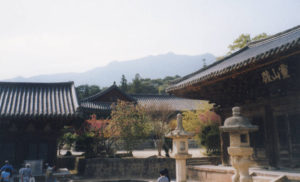 The temple was tucked into a valley with a stream running beside it. The grounds were festooned with paper lanterns, decorations for the upcoming celebration honoring the Buddha’s birthday. She explained the story of why lanterns line the way into the temple. The Buddha was coming to visit and all the people of the town put out beautiful lanterns to line the way. A poor woman wanted to contribute as well, but she could not afford a lantern. The only thing she had was long, beautiful hair. She cut her hair and made a small lantern with a little oil. However, when she tried to put it with all the others, the town’s people ridiculed her and tried to extinguish it and get rid of the lantern. The Buddha heard of this and told everyone that hers would be the only lantern that lasted. The next day all the other lanterns were ruined, but hers remained. Now people donate lanterns to line the way into the temple.
The temple was tucked into a valley with a stream running beside it. The grounds were festooned with paper lanterns, decorations for the upcoming celebration honoring the Buddha’s birthday. She explained the story of why lanterns line the way into the temple. The Buddha was coming to visit and all the people of the town put out beautiful lanterns to line the way. A poor woman wanted to contribute as well, but she could not afford a lantern. The only thing she had was long, beautiful hair. She cut her hair and made a small lantern with a little oil. However, when she tried to put it with all the others, the town’s people ridiculed her and tried to extinguish it and get rid of the lantern. The Buddha heard of this and told everyone that hers would be the only lantern that lasted. The next day all the other lanterns were ruined, but hers remained. Now people donate lanterns to line the way into the temple.
Apart from these copious notes, stamps in our passports, and two W200 coins, there is little indication we have ever been to Korea. This whirlwind touring aspect is not one of my favorite portions of the cruise. See the world from the comfort of your hotel room. Port to port. On the bus. Off the bus. Go with the herd. Follow the person with the flag. Moo. If there is something we like, there is no option to linger; if there is something we dislike, no option to depart.
While I consider the good guide we had a positive aspect of “Cruise Culture” I was constantly reminded of the less positive ones. The first portion of the tour was essentially babysitting. People could not figure out how to turn on the air-conditioning vents, and then they needed them turned off. Then someone opened an overhead window that they could not close. The guide was too hard to hear. Then the guide was too loud. It got better later after the effort of complaining tired them out and put them to sleep. Anna wondered what tour they were on; moreover what they would tell everyone they saw.
Upon reflection, I choose to carry with me a fable the guide shared with us, illustrating the Buddhist perspective of life. One evening, a monk drinks sweet, fresh water from a pool. In daylight, he discovers that the water to have been brackish. The world is what you perceive it to be.
Excerpts from Anna’s journal included
This entry was posted in Around the World